 On 18th November 2024, the National Statistical Office (NSO) under the Ministry of Statistics and Programme Implementation (MoSPI) released the 24th Periodic Labour Force Survey (PLFS) Quarterly Bulletin (July to September 2024).
On 18th November 2024, the National Statistical Office (NSO) under the Ministry of Statistics and Programme Implementation (MoSPI) released the 24th Periodic Labour Force Survey (PLFS) Quarterly Bulletin (July to September 2024).
As per the report, Unemployment Rate (UR) in urban areas among persons aged 15 years and above has decreased by 20 basis points (bps), to 6.4% in 2nd Quarter(Q2: July-September) of Financial Year 2024-25 (FY25), from 6.6% in Q2 of FY24. This marks the lowest UR since the inception of PLFS in April-June 2017.
- Also, this was the 2nd consecutive quarter of a decline in the UR for urban areas, after the UR had increased up to 6.7% during the Q4(January-March) of FY24.
- The UR among females (aged 15 years and above) in urban areas has decreased marginally to 8.4% in Q2FY25 from 8.6% in the same quarter of FY24 and 9% in Q1FY25. This marks the 5th consecutive quarter of the female UR has been above 8%.
- While, the UR among males (aged 15 years and above) in urban areas has decreased from 6% (in Q2FY24) to 5.7% in Q2FY25. The rate was 5.8% in Q1FY25.
Assessment:
i.For urban areas, the quarterly PLFS data measures labour market indicators like: UR, Labour Force Participation Rate (LFPR), and Worker Population Ratio (WPR) based on the Current Weekly Status (CWS).
ii.At the national level, in the urban areas, a total number of 5,739 First Stage Units (FSUs) (urban sampling unit curved out from Urban Frame Survey) have been surveyed during the Q2FY25.
iii.The number of urban households surveyed was 45,005 and number of persons surveyed was 1,70,598 in urban areas.
Note: CWS is the activity status is determined on the basis of a reference period of last 7 days preceding the date of survey is known as the Current Weekly Status (CWS) of the person.
Youth Unemployment Rate (UR):
i.The UR in CWS among the urban youth aged 15-29, declined from16.8% (in Q2FY24) to 15.9% (Q2FY25).
ii.The PLFS data showed that the UR for young females declined at a faster rate for young males in Q2FY25.
LFPR:
i.It is defined as the percentage of a persons in labour force i.e. working or seeking or available for work, in the population.
ii.The LFPR in CWS in urban areas among persons aged 15 years and above has surged to a record-high of 50.4% in Q2 of FY25 compared to 49.3% for same quarter of FY24.
iii.LFPR for females in urban areas among persons aged 15 years and above has increased from 24.0% (in July –September 2023) to 25.5% (in July-September 2024).
- While, LFPR for male of same age group in urban areas has increased from 73.8% (in Q2FY24) to 75.0% (in Q2FY25).
WPR:
i.It is defined as the percentage of employed persons in the population.
ii.WPR in urban areas among persons aged 15 years and above has increased to 47.2% in Q2 FY25 from 46.0% in Q2FY24.
iii.WPR for male of age 15 years and above for urban areas has increased from 69.4% (in Q2FY24) to 70.7% (Q2FY25), reflecting overall increasing trend in male WPR.
- While, the WPR for female of the same age group in urban areas has increased from 21.9% (in Q2FY24) to 23.4% (in Q2FY25).
Employment Composition:
i.The share of salaried workers has increased to 23.1% (in Q2FY25) from 22% for the same quarter of FY24 and 22.6% (in Q1FY25).
ii.The share of persons engaged as own account worker and employers rose to 15.3% (in Q2FY25) from 14.4% (in Q2FY24) but marginally lower than 15.4% in the preceding quarter of FY25.
Other Key Points:
i.The PLFS quarterly data for Q2of FY25 revealed that despite the overall UR for urban area has decreased, Jammu & Kashmir (J&K) registered highest UR in urban areas with 11.8%.
- It is followed by Odisha (10.6%), Chhattisgarh (10.4%) and Kerala (10.1%) ranked at 2nd, 3rd and 4th position in terms of UR in urban areas.
ii.As per the PLFS data, Delhi recorded the lowest UR in the country with 2.6% in Q2FY25, followed by Gujarat (4.0%), Karnataka (4.8%), Punjab (4.9%) and Haryana (5%).
ii.Among 22 states and Union Territories (UTs), 14 have highest UR than the national average, while 8 has lower UR than that.




